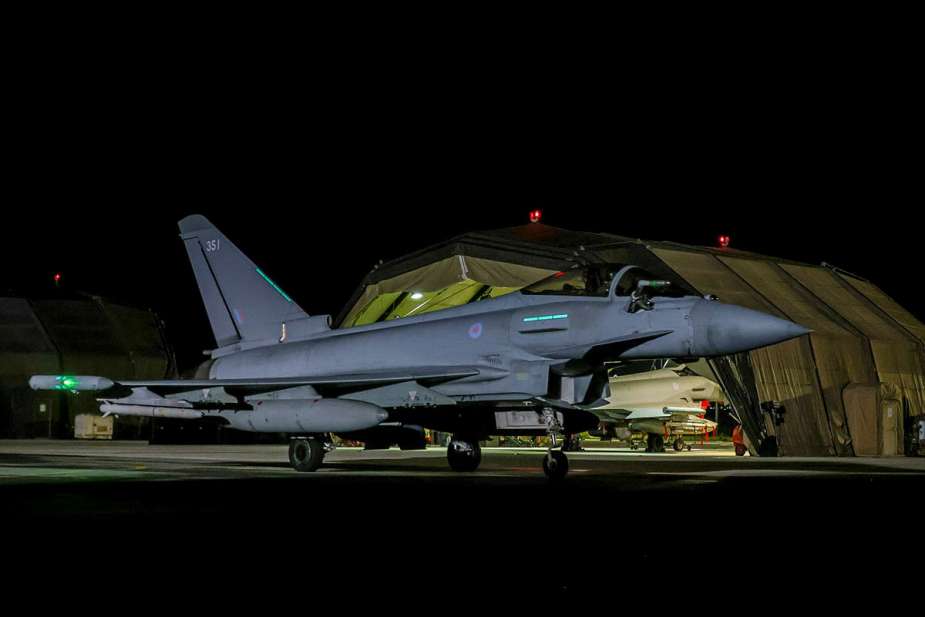On April 14, 2024, British Prime Minister Rishi Sunak confirmed that Royal Air Force (RAF) Typhoon FGR4 fighters shot down several Iranian attack drones. This defensive action aimed to protect Israel and neighboring countries during Iran's unprecedented overnight attack on Israeli soil from October 13 to 14, 2024. While the exact number of intercepted drones was not specified, the UK's contribution though likely less than the 70 drones claimed by the US and several others intercepted by Jordan was crucial.
Follow Army Recognition on Google News at this link

Four Royal Air Force Typhoon FGR4s, supported by a pair of Voyager tankers, joined US forces in a deliberate strike against Houthi sites in Yemen on January 2024 (Picture source: RAF )
The UK's involvement is part of a military cooperation agreement signed with Israel in 2020, which, although confidential, does not specifically require the UK to intervene if Israel is attacked. However, Sunak emphasized that the UK's engagement was about saving lives, not just in Israel but also in neighboring countries such as Jordan, and is a continuation of the air campaign against the Islamic State in Iraq and Syria.
The British Prime Minister can take military action without prior Parliamentary approval, thanks to royal prerogative powers. Although a recent convention suggests that Parliament should be consulted, exceptions are allowed in emergencies. This approach was followed for recent Middle East operations but not for strikes against Yemen's Houthis, where Parliament was not consulted.
RAF (British Royal Air Force) also supported US Air Force missions in Iraq and Syria, focusing American efforts to assist Israel. British Typhoons were redeployed to RAF Akrotiri in Cyprus to support these operations. Sunak also announced that an update would be provided to Parliament, resuming after the Easter break, in a session where ministers will likely face pressure to proscribe Iran's Islamic Revolutionary Guards as a terrorist organization, a measure supported by several British politicians despite the Foreign Office's concerns about potentially severing diplomatic ties with Tehran.
The Eurofighter Typhoon FGR4 is an advanced multi-role fighter jet operated primarily by the Royal Air Force (RAF). Known for its agility and high performance, it is equipped with state-of-the-art avionics and electronics that enable it to conduct air superiority and ground attack missions effectively. The Typhoon FGR4 features a delta wing and canard design which provides exceptional maneuverability and stability at various speeds. Its armament includes a combination of air-to-air missiles, air-to-surface missiles, and an internal cannon, making it well-suited for a variety of combat scenarios.
The Typhoon FGR4 is powered by two Eurojet EJ200 engines, offering a top speed of over Mach 2 and a service ceiling above 55,000 feet. It has a sophisticated radar and sensor suite that supports a wide range of operational tasks, from surveillance to precision strike. The aircraft is a crucial part of the UK's defense strategy, regularly updated and integrated with the latest technology to maintain its edge in modern warfare. It has been deployed in various international missions including patrols in disputed airspaces and operations against the Islamic State.
The RAF Typhoon can be equipped with several types of missiles, including the Advanced Short Range Air-to-Air Missile (ASRAAM). This missile is particularly used for engaging aerial targets such as drones. The ASRAAM is known for its high-speed interception capabilities and can engage targets at significant distances, making it effective in scenarios where drones pose a threat.
Shooting down drones with a jet like the Typhoon FGR4 involves significant complexity. Drones are generally smaller and less predictable than manned aircraft, which can make them harder to detect and target. The high speed of jet fighters also means that pilots need to make rapid decisions and precise maneuvers to align their missile systems for effective engagement. The use of advanced targeting systems and infrared-guided missiles like the ASRAAM helps in these situations by allowing the missile to lock onto the heat signatures of drones, thus compensating for some of the difficulties posed by their small size and agility.
Defense News April 2024
















